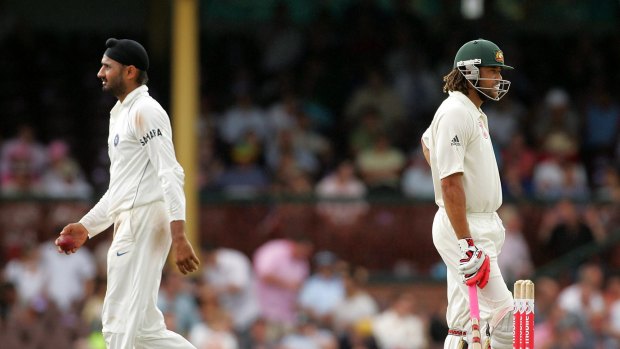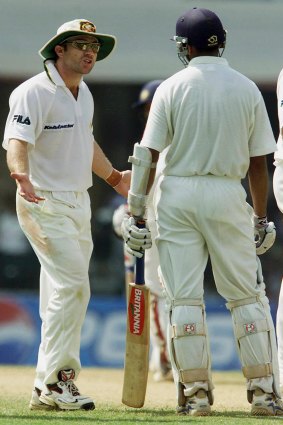By Daniel Lane
When Indian prime minister Narendra Modi landed in Brisbane for the G20 summit with two of his nation's greatest cricketers, Sunil Gavaskar and Kapil Dev, in tow as members of his official party, his nation's political commentators described it as "crafty" to employ cricket diplomacy in sports-mad Down Under.
However, if the series between Australia and India — of which the next instalment starts at the Gabba in less than three weeks time — had proven anything since Lala Amarnath led his then newly independent country's team on its first tour here in 1947-48 it's that the cricket pitch is a battlefield.

Chequered past: Harbhajan Singh and Andrew Symonds in 2008.Credit: Getty Images
Over the years the series staged in both countries have been plagued by riots, claims of racism and threats to abandon the tour mid-series; even Gavaskar, his Prime Minister's ambassador of G20 summit goodwill, staged his own walk-off against the Aussies in 1981.
Numerous theories exist as to why passions run so high between the two teams. One suggests India had never forgiven the fact they were dismissed as a force by Australia's Cricket Board because they weren't invited back until 20 years after their first tour — and Don Bradman's last series — '47-48.

Michael Slater confronts Rahul Dravid in 2001.Credit: Reuters
The second and third tours were punctuated by an additional 10 years. The hospitality the Indians "enjoyed" in 1967 must have been questionable, too, if suggestions the tourists were so poorly looked after they were spotted catching eels in the Brisbane River for their dinner.
Cricket Australia introduced its Spirit of Cricket pledge a few years ago and it promises to respect others. However, Brett Lee – who has immersed himself in the subcontinent's rich and colourful culture – said it was his greatest hope for this summer that the relationships that'd been forged through Aussies and Indians playing alongside one another in the IPL's Twenty20 competition would matter when the blood rushed and tempers frayed during the heat of battle.
"There have been incidents over the years, and they ought to be done and dusted now," Lee said. "The fact is Australian and Indian players get on extremely well. The Indian Premier League has brought a lot of players together from all over the world and the friendships are good.
"I'm all for being mates off the field, and through playing with guys like Sachin Tendulkar and VVS Laxman, I can go anywhere and we'll catch up as friends.
"When you walk over that white line to play you want to be competitive but I think the boundaries are being softened because players from different countries are becoming friends. It's really changing now, in the early 2000s I was bowling rockets at VVS Laxman in Perth but the other week I did a video for his surprise 40th birthday party."
1. Mankad enters his name in cricket's vocabulary (1947-48)
Vinoo Mankad was considered by many not to be playing in the spirit of cricket when he ran out Australia's opener Bill Brown while he was backing up in the second Test. He broke the stumps at the non-striker's end as he ran into bowl and Brown was out of his ground. It was the second time he'd dismissed Brown in that manner on the tour and while he was howled down by the Australian media for "Mankading", he was supported by Don Bradman who wrote of the incident: "The laws of cricket make it quite clear that the non-striker must keep within his ground until the ball has been delivered. If not, why is the provision there which enables the bowler to run him out? By backing up too far or too early, the non-striker is very obviously gaining an unfair advantage."
2. Fire and brimstone in Bombay (1969-70)
When Indian batsman Srinivas Venkataraghavan was given out caught behind when a lone fielder appealed it outraged fans. Australian wicketkeeper Brian Taber's belief he'd "missed it by a mile" was echoed by the radio commentators and the fans grew angry that Australian captain Bill Lawry did not call him back. The stands were set ablaze, the fielders were bombarded with bottles and seats and crowds chanted their outrage. As Australia's pace bowler Graham McKenzie charged in to bowl a large stone almost hit him. The Aussies were told to wait in the middle for 20 minutes after play and many armed themselves with the stumps for protection. When Doug Walters was asked why he had the ball as a weapon he replied: "I'll try and poke someone's eye out with it."
3. Targeting Doug Walters in Calcutta (1969-70)
Lawry's men arrived in Calcutta and found a city in chaos. Scores of refugees fled floods in East Pakistan and communists had made their presence felt. Many were angered – wrongly – by the belief that Doug Walters had served in the Vietnam war and the team hotel was surrounded by a mob. "We were warned there was going to be a riot at our hotel," wrote Walters in his autobiography. Apparently there were posters all over Calcutta claiming that I had been in Vietnam killing the Vietcong. We were warned to stay indoors and have everything locked. The authorities told us there would be trouble at 6.30 that night and, sure enough, right on the dot a mob came around and smashed in the windows and front doors."
4. Bill Lawry nails photographer in Calcutta (1969-70)
After a tough 10-week tour Lawry was targeted for public and media anger due to a number of incidents. With Australia needing only 39 runs to win a crowd disturbance forced a 15-minute delay. A photographer used it to his advantage to take snaps, and refused to leave the field when play resumed. "The 'Phantom' made a bit of a run at him and, in fact, pushed him over," wrote Walters. The newspaper made an issue of the altercation and Walters recalled a gang of "hooligans" lined the road the next day when the team left for the airport and bombarded the Aussies with rocks. "It was a great challenge," Lawry later said of the tour. "It was probably the toughest tour I ever went on. There were very pleasant memories on the field but very unpleasant ones off it."
5. Sunil Gavaskar's walk-off (1981)
India's famous series-levelling win was marred by Sunil Gavaskar's decision to leave the field with his fellow opener Chetan Chauhan after umpire Rex Whitehead gave him out LBW to Dennis Lillee. The innings was crucial, the Indian master had broken a drought and reached 70 when Lillee rapped him on the pads. Gavaskar refused to accept Whitehead's decision and gave Chauhan the marching orders to follow him into the pavilion. Chauhan was told by team management to return.
6. Slater loses his cool (2001)
When Rahul Dravid mistimed a pull shot Michael Slater dived to take a catch. Dravid, however, refused to budge and the umpire, former India captain Srinivas Venkatraghavan – of 1969 Bombay riot fame – gave him not out. Replays showed an element of doubt but incensed at having his integrity questioned, Slater claimed it was a clean catch. He argued with the umpire before letting Dravid know how he felt.
7. Monkeygate (2007-08)
Harbhajan Singh was charged with racial abuse in an altercation with Andrew Symonds. The spin bowler was banned by the match referee Mike Procter for three Test matches but the charges were downgraded to using abusive language and the ban was lifted. The Indian team had protested the punishment and threatened to go home. "After the hearing, there was serious ill-feeling between the two teams and we felt betrayed by the turn of events," wrote Sachin Tendulkar. "I stated exactly what I had heard and seen and also said that I had taken exception to us being labelled 'liars' by the match referee, Mike Procter, who had mentioned in his statement that 'I believe one group is telling the truth'. That he banned 'Bhajji' for three Test matches seemed to us to show which group, in his opinion, was lying. It is never a pleasant thing to be called a liar and I was extremely angry." Former Australian captain Allan Border, who was an official with Cricket Australia, revealed the feeling in the Aussie camp when he wrote: "When the Indians started to flex their muscles and threatened to go home, our players were aggrieved. They felt if the situation had been reversed and any of them had called someone a monkey, they'd have been hammered."
8. The bird's-eye view (2011-12)
Virat Kohli was fined half his match fee for flipping the bird to a mob who sledged him at the SCG. He tweeted: "I agree cricketers don't have to retaliate, what when the crowd says the worst things about your mother and sister, the worst I've heard."